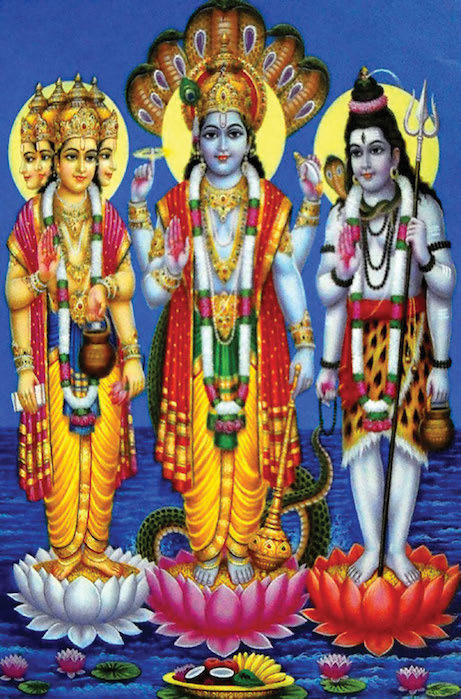
As you know, Hinduism is a polytheistic religion, meaning that its followers believe in more than one god. In fact, worshippers commonly devote themselves to one god, their personal deity. Household shrines feature pictures and statues of the chosen gods. Individuals may choose this god for its special attributes. For example, Ganesh, the god with the head of an elephant, is known for overcoming obstacles and bringing success.
Some of these gods appear in the famous Hindu epics, the Ramayana and the Mahabarata. These poems originated from the storytelling and parables of the Brahmins and ascetics. In present-day India these stories are beloved and more popular than the Vedas and Upanishads. Accessible and entertaining, rich with heroes and villains, they simultaneously provide moral and spiritual instruction.
The Rig-Veda introduced the foremost of the Hindu gods: Brahama, Vishnu, and Shiva. Although each of these deities possess special attributes, many Hindus believe they represent three properties of one god. Together they form the Hindu Trinity.
Brahma: The Creator
Brahma is considered the mystical creator,the supreme presence, or God. Many Hindus believe that all other gods originate from Brahma. To the right is a depiction ofBrahma. His four faces stand for the four corners of the universe. He holds a sacrifi-cial ladle, the four Vedas, a jar of holywater from the Ganges, and a necklace ofprayer beads. Like all Hindu gods, he sitsupon a lotus throne.
At one time in the past, the two of the Hindu triad — Brahma and Vishnu — began an argument on who the most powerful of the triad was. The argument became so heated that the other gods asked Shiva, the third of the triad, to intervene. Shiva assumed the form of a gigantic lingam (the phallic symbol of Shiva that depicts him as a creator). The lingam was of flaming fire and it went up to the heavens and descended into the nether regions underneath the earth. Both Brahma and Vishnu agreed that if they could find how enormous the fiery lingam was they could determine who among the triad was the most powerful. Brahma took the form of a swan and went upwards along the length of the ascending lingam while Vishnu assumed the form of a boar and descended along the lingam into the nether regions. Both went on and on but neither could reach the ends. Vishnu, being very clever, realized that he had been outdone by Shiva and came back to acknowledge Shiva as the greatest of the triad. Unfortunately, Brahma decided that he could get past Shiva with trickery. On his ascent to determine the end of the upper part of the lingam, Brahma had passed the ketaki flower (Pandanus odorifer). Brahma requested ketaki, who was used to inhabit the upper end regions of the lingam, to testify before Shiva that he, Brahma, had reached the uppermost end. Ketaki agreed and, when brought before Shiva, the flower told Shiva that he had observed Brahma reach the upper end of the lingam. Shiva was angered at this lie. He cursed Brahma with the horror of not ever being worshipped on earth while he also cursed the flower with the depressing eternal condition of never ever being used in any Hindu worshiping rituals.
Brahma is normally depicted as having 4 heads, though originally, he had 5. When Brahma made the universe, generated a female partner, Saraswati, out of his own substance. Through her he gave birth to the human race and represents maximum knowledge and wisdom. Brahma was charmed by his creation and had never seen such fine beauty and so he could see her from all angles, gave himself 4 heads. Where ever Saraswati went, see saw Brahma staring at her. Disgusted, she flew upward. Then, Brahma created a fifth head to look upward. Shiva was agitated by this and felt Saraswati was like Brahma’s daughter and he should be protecting her. To teach him a lesson, Shiva opened his third eye and burned off Brahma’s fifth head.
Vishnu: The Preserver
“Whenever the Sacred Law fails, and evil raises its head, I (Vishnu) take embodied birth. To guard the righteous, to root out sinners, and to establish Sacred Law, I am born from age to age.” (Bhagavad Gita IV. 6-8)
Followers of Vishnu worship him as the preserver, greatest of the gods. His role is to maintain a balance between good and evil powers in the universe. In order to do this, Vishnu returns to earth in different forms, both animal and human. Tradition holds that there are ten avatars, incarnations, linked to Vishnu. However, only Rama and Krishna remain the focus of worship among Hindus. Here are the ten incarnations of Vishnu and the task each performed:
MATSYA (FISH): As a giant fish, Vishnu warned the world of a great flood, rescuing both a famous sage and the Vedas from the flood.
KURMA (TORTOISE): After the flood, Vishnu, in the form of a huge tortoise, retrieved the gods’ elixir of immortality, which was lost in the depths of the ocean.
VARAH (BOAR): After the demon Hiranyakasipu plunged the earth into the ocean, Vishnu, in the form of boar, hoisted the world above water.
NARASIMHA (MAN-LION): In order to destroy another demon, Vishnu became half-man, half-lion. This was because the demon, Hiranyakasipu, could be killed by neither animal nor man alone.






Be the first to comment